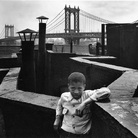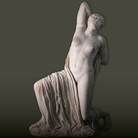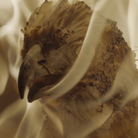Marcel Duchamp & John Cage. Les grands trans-parents

Dal 7 May 2015 al 31 May 2015
Venezia
Luogo: Archivio Emily Harvey
Indirizzo: San Polo 387
Orari: da mercoledì a sabato 17-20
Costo del biglietto: ingresso gratuito
Telefono per informazioni: +39 041 5226727
E-Mail info: ehf@emilyharveyfoundation.org
Sito ufficiale: http://www.emilyharveyfoundation.org
“La verità e l’importanza del lavoro di un artista stanno nella verità e nell’importanza di ciò che esso ci permette di fare – nei pensieri che ci aiuta a pensare e nelle azioni che ci aiuta a compiere”.
Henry Martin
“Marcel Duchamp TU M’…emmerdes parce que tu as tout soulagé comme art, parce que tu as tout inventé comme art, parce que tu as tout fait passer comme art”.
Antonio d’Avossa
Parafrasando Henry Martin, perché Duchamp (e perché Cage) oggi? E’ così universalmente riconosciuto che sono stati loro, nel secolo scorso, a chiudere e ad aprire contemporaneamente una porta sull’arte, è così sterminata la letteratura che li riguarda, che poco si potrebbe aggiungere, a meno di essere poeti o illuminati, artisti insomma.
Mi limiterò quindi a raccontare la genesi di questa (queste) mostra (mostre). Tre anni fa, un’amica parigina, Jacqueline Sigaar, mi ha regalato il film di Allan Miller su John Cage “I have nothing to say and I am saying it”, di cui è stata co-produttore. Nel film la presenza di Duchamp è rilevante e soprattutto è rilevante lo spirito, la ricerca del nuovo, lo sconfinamento vertiginoso in tutte le dimensioni possibili che accomuna questi due grandi… in breve me ne sono innamorata e ho incominciato a pensare a un’occasione per presentarlo. All’inizio c’era la piccola idea di una manifestazione solo di documenti, libri, cataloghi, video, di cui ho una collezione abbastanza vasta, poi le cose si sono complicate, sono diventate molto più ambiziose. E in modo quasi casuale (“Io non cerco, trovo”, ha detto Picasso) sono cominciate ad apparire le opere. La mia prima idea di titolo era “Les Grands Parents” che Antonio d’Avossa ha trasformato in “Les Grands Trans-Parents” (Breton docet) e che Henry Martin ha arricchito con i suoi sottotitoli: entrambi hanno contribuito con due testi che non esito a definire “poetici”. Poi le cose si sono ancora complicate: frugando nella memoria e in quell’immenso caos che è il mio archivio, ho trovato una serie di opere di artisti più contemporanei, in cui Duchamp e Cage sono il riferimento esplicito. Ad alcuni altri ho chiesto se volevano contribuire con un lavoro nuovo ed è stato molto eccitante per me, scoprire quanti si sono riconosciuti come “nipoti” dei grandi “nonni”. Li ringrazio tutti con grande passione.
Desidero anche ringraziare Antonio d’Avossa e Henry Martin e tutti coloro in qualche modo hanno contribuito a rendere possibile questa avventura: Piero Cavellini, Valeria Carrega, Enzo e Edda Gazzerro, Nanni Ghio, Carlo Palli, Mauro Panichella, Raccolta dei Campiani, Jacqueline Sigaar, Aldo Spinelli, Nicola Trentalance.
Caterina Gualco
Henry Martin
“Marcel Duchamp TU M’…emmerdes parce que tu as tout soulagé comme art, parce que tu as tout inventé comme art, parce que tu as tout fait passer comme art”.
Antonio d’Avossa
Parafrasando Henry Martin, perché Duchamp (e perché Cage) oggi? E’ così universalmente riconosciuto che sono stati loro, nel secolo scorso, a chiudere e ad aprire contemporaneamente una porta sull’arte, è così sterminata la letteratura che li riguarda, che poco si potrebbe aggiungere, a meno di essere poeti o illuminati, artisti insomma.
Mi limiterò quindi a raccontare la genesi di questa (queste) mostra (mostre). Tre anni fa, un’amica parigina, Jacqueline Sigaar, mi ha regalato il film di Allan Miller su John Cage “I have nothing to say and I am saying it”, di cui è stata co-produttore. Nel film la presenza di Duchamp è rilevante e soprattutto è rilevante lo spirito, la ricerca del nuovo, lo sconfinamento vertiginoso in tutte le dimensioni possibili che accomuna questi due grandi… in breve me ne sono innamorata e ho incominciato a pensare a un’occasione per presentarlo. All’inizio c’era la piccola idea di una manifestazione solo di documenti, libri, cataloghi, video, di cui ho una collezione abbastanza vasta, poi le cose si sono complicate, sono diventate molto più ambiziose. E in modo quasi casuale (“Io non cerco, trovo”, ha detto Picasso) sono cominciate ad apparire le opere. La mia prima idea di titolo era “Les Grands Parents” che Antonio d’Avossa ha trasformato in “Les Grands Trans-Parents” (Breton docet) e che Henry Martin ha arricchito con i suoi sottotitoli: entrambi hanno contribuito con due testi che non esito a definire “poetici”. Poi le cose si sono ancora complicate: frugando nella memoria e in quell’immenso caos che è il mio archivio, ho trovato una serie di opere di artisti più contemporanei, in cui Duchamp e Cage sono il riferimento esplicito. Ad alcuni altri ho chiesto se volevano contribuire con un lavoro nuovo ed è stato molto eccitante per me, scoprire quanti si sono riconosciuti come “nipoti” dei grandi “nonni”. Li ringrazio tutti con grande passione.
Desidero anche ringraziare Antonio d’Avossa e Henry Martin e tutti coloro in qualche modo hanno contribuito a rendere possibile questa avventura: Piero Cavellini, Valeria Carrega, Enzo e Edda Gazzerro, Nanni Ghio, Carlo Palli, Mauro Panichella, Raccolta dei Campiani, Jacqueline Sigaar, Aldo Spinelli, Nicola Trentalance.
Caterina Gualco
SCARICA IL COMUNICATO IN PDF
COMMENTI

-
 Dal 2 December 2025 al 19 February 2026
Milano | Centro Culturale di Milano
Dal 2 December 2025 al 19 February 2026
Milano | Centro Culturale di Milano
Walter Rosenblum. Il mondo e la tenerezza
-
 Dal 30 November 2025 al 12 April 2026
Gallarate | Museo MA*GA
Dal 30 November 2025 al 12 April 2026
Gallarate | Museo MA*GA
Kandinsky e l’Italia
-
 Dal 29 November 2025 al 12 April 2026
Roma | Musei Capitolini
Dal 29 November 2025 al 12 April 2026
Roma | Musei Capitolini
La Grecia a Roma
-
 Dal 22 November 2025 al 3 May 2026
Torino | Sale Chiablese dei Musei Reali
Dal 22 November 2025 al 3 May 2026
Torino | Sale Chiablese dei Musei Reali
Orazio Gentileschi. Un pittore in viaggio
-
 Dal 20 November 2025 al 25 January 2026
Firenze | Palazzo Strozzi
Dal 20 November 2025 al 25 January 2026
Firenze | Palazzo Strozzi
Andro Eradze. Bones of Tomorrow
-
 Dal 21 November 2025 al 28 March 2026
Cuneo | Complesso Monumentale di San Francesco
Dal 21 November 2025 al 28 March 2026
Cuneo | Complesso Monumentale di San Francesco
La Galleria Borghese. Da Raffaello a Bernini. Storia di una collezione


